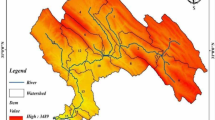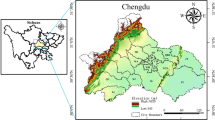Abstract
Net primary productivity (NPP) is the most important index that represents the structure and function of the ecosystem. NPP can be simulated by dynamic global vegetation models (DGVM), which are designed to represent vegetation dynamics relative to environmental change. This study simulated the NPP of China’s ecosystems based on the DGVM Integrated Biosphere Simulator (IBIS) with data on climate, soil, and topography. The applicability of IBIS in the NPP simulation of China’s terrestrial ecosystems was verified first. Comparison with other relevant studies indicates that the range and mean value of simulations are generally within the limits of observations; the overall pattern and total annual NPP are close to the simulations conducted with other models. The simulations are also close to the NPP estimations based on remote sensing. Validation proved that IBIS can be utilized in the large-scale simulation of NPP in China’s natural ecosystem. We then simulated NPP with climate change data from 1961 to 2005, when warming was particularly striking. The following are the results of the simulation. (1) Total NPP varied from 3.61 GtC/yr to 4.24 GtC/yr in the past 45 years and exhibited minimal significant linear increase or decrease. (2) Regional differences in the increase or decrease in NPP were large but exhibited an insignificant overall linear trend. NPP declined in most parts of eastern and central China, especially in the Loess Plateau. (3) Similar to the fluctuation law of annual NPP, seasonal NPP also displayed an insignificant increase or decrease; the trend line was within the general level. (4) The regional differences in seasonal NPP changes were large. NPP declined in spring, summer, and autumn in the Loess Plateau but increased in most parts of the Tibetan Plateau.
Similar content being viewed by others
References
Cao Mingkui, Tao Bo, Li Kerang et al., 2003. Interannual variation in terrestrial ecosystem carbon fluxes in China from 1981 to 1998. Acta Botanica Sinica, 45(5): 552–560. (in Chinese)
Delire C, Foley J A, 1999. Evaluating the performance of a land surface/ecosystem model with biophysical measurements from contrasting environments. Journal of Geophysical Research-Atmospheres, 104(D14): 16895–16909.
Ding Yihui, Ren Guoyu, Shi Guangyu et al., 2006. National assessment report of climate change (I): Climate change in China and its future trend. Advances in Climate Change Research, 2(1): 3–8. (in Chinese)
El Maayar M, Price D, Delire T C et al., 2001. Validation of the integrated biosphere simulator over Canadian deciduous and coniferous boreal forest stands. Journal of Geophysical Research-Atmospheres, 106(D13): 14339–14355.
El Maayar M, Price D T, Black T A et al., 2002. Sensitivity tests of the integrated biosphere simulator to soil and vegetation characteristics in a pacific coastal coniferous forest. Atmosphere-Ocean, 40(3): 313–332.
Field C B, Behrenfeld M J, Randerson J T et al., 1998. Primary production of the biosphere: Integrating terrestrial and oceanic components. Science, 281(5374): 237–240.
Foley J A, Levis S, Prentice I C et al., 1998. Coupling dynamic models of climate and vegetation. Global Change Biology, 4(5): 561–579.
Foley J A, Prentice I C, Ramankutty N et al., 1996. An integrated biosphere model of land surface processes, terrestrial carbon balance, and vegetation dynamics. Global Biogeochemical Cycles, 10(4): 603–628.
Friend A D, Stevens A K, Knox R G et al., 1997. A process-based terrestrial biosphere model of ecosystem dynamics (Hy-brid v3.0). Ecological Modelling, 95(2/3): 249–287.
Fu Bojie, Niu Dong, Zhao Shidong, 2005. Study on global change and terrestrial ecosystems: History and prospect. Advance in Earth Sciences, 20(5): 556–560. (in Chinese)
Gao Zhiqiang, Liu Jiyuan, Cao Mingkui, 2004. Impacts of land use and climate change on regional net primary productivity. Journal of Geographical Sciences, 14(3): 581–591.
Haxeltine A, Prentice I C, 1996. BIOME3: An equilibrium terrestrial biosphere model based on eco-physiological constraints and competition among plant functional types. Global Biogeochemical Cycles, 4(10): 693–708.
Huang Mei, 2006. Study of the water, energy and carbon fluxes of China’s terrestrial ecosystems. Beijing: Ph.D Dissertation of Institute of Geographic Sciences and Natural Resources Research, CAS. (in Chinese)
Hutchinson M F, 2004. Anusplin version 4.3 user guide. The Australia National University, Center for Resource and Environment Studies, Canberra.
IPCC, 2007. Climate Change 2007: The Physical Science Basis: Contribution of Working Group I to the Fourth Assessment Report of the Intergovernmental Panel on Climate Change. Cambridge: Cambridge University Press.
Kucharik C J, Barford C C, El Maayar M et al., 2006. A multiyear evaluation of a dynamic global vegetation model at three AmeriFlux forest sites: Vegetation structure, phenology, soil temperature, and CO2 and H2O vapor exchange. Ecological Modelling, 196(1/2): 1–31.
Kucharik C J, Foley J A, Delire C et al., 2000. Testing the performance of a dynamic global ecosystem model: Water balance, carbon balance, and vegetation structure. Global Biogeochemical Cycles, 14(3):795–825.
Lieth H, Whittaker R H, 1975. Primary Productivity of the Biosphere. Berlin: Springer.
Liu J X, Price D T, Chen J A, 2005. Nitrogen controls on ecosystem carbon sequestration: A model implementation and application to Saskatchewan, Canada. Ecological Modelling, 186: 178–195.
Liu Shirong, Wu Deying, Wang Bing et al., 1993. Impacts of climate change on productivity of forests in China. Forest Research, 6(6): 633–642. (in Chinese)
Liu Zhiang, Ma Qinyan, Pan Xiangli, 1994. Study of the biomass and productivity of natural Larix gmelini. Acta Phytoecologica Sinica, 18(4): 328–337.
Matthew P A, Lombardero M J, 2000. Assessing the consequences of global change for forest disturbance from herbivores and pathogens. Science of the Total Environment, (262): 263–286.
Naik V, Wuebbles D J, DeLucia E H et al., 2003. Influence of geoengineered climate on the terrestrial biosphere. Environmental Management, 32(3): 373–381.
Ni J, 2000. Net primary production, carbon storage and climate change in Chinese biomes. Nordic Journal of Botany, 20(4): 415–426.
Parry M L, Canziani O F, Palutikof J P et al., 2007. Climate Change 2007: Impacts, adaptation and vulnerability: Contribution of Working Group II to the Fourth Assessment Report of the Intergovernmental Panel on Climate Change. Cambridge: Cambridge University Press.
Parton W J, Scurlock J M O, Ojima D S, 1993. Observations and modeling of biomass and soil organic matter dynamics for grassland biome worldwide. Global Biogeochemical Cycles, 7(4): 785–809.
Piao S L, Fang J Y, 2003. Seasonal changes in vegetation activity in response to climate changes in China between 1982 and 1999. Acta Geographica Sinica, 58(1): 119–125. (in Chinese)
Prentice I C, Cramer W, Harrison S P et al., 1992. A global biome model based on plant physiology and dominance, soil properties and climate. Journal of Biogeography, 19(2): 117–134.
Ruimy A, Saugier B, Dedieu G, 1994. Methodology for the estimation of terrestrial net primary production from remotely sensed data. Journal of Geophysical Research, 99(D3): 5263–5283.
Running S W, Gower S T, 1991. Forest-BGC, a general model of forest ecosystem processes for regional applications (II): Dynamic allocation and nitrogen budgets. Tree Pbysiol., 9: 147–160
Sitch S, Prentice I C, Smith B, 2000. LPJ: a coupled model of vegetation dynamics and the terrestrial carbon cycle. In: Sitch S (ed.). The role of vegetation dynamics in the control of atmospheric CO2 content. Lund: Ph.D Dissertation of Lund University.
Sun Rui, Zhu Qijiang, 2001. Effect of climate change of terrestrial net primary productivity in China. Journal of Remote Sensing, 5(1): 58–61. (in Chinese)
Tao Bo, Li Kerang, Shao Xuemei et al., 2003. The temporal and spatial patterns of terrestrial net primary productivity in China. Journal of Geographical Sciences, 13(2): 163–171.
Twine T E, Kucharik C J, Foley J A, 2004. Effects of land cover change on the energy and water balance of the Mississippi River basin. Journal of Hydrometeorology, 5(4): 640–655.
Vano J A, Foley J A, Kucharik C J et al., 2006. Evaluating the seasonal and interannual variations in water balance in northern Wisconsin using a land surface model. Journal of Geophysical Research-Biogeosciences, 111, doi: 10.1029/2005JG000112.
Wang Yuhui, Zhou Guangsheng, Jiang Yanling et al., 2001. Estimating biomass and NPP of Larix forests using forest inventory data. Acta Phytoecologica Sinica, 25(4): 420–425. (in Chinese)
Wang Zongming, Liang Yinli, 2002. Progress in vegetation net primary productivity model research. Journal of Northwest Forestry College, 17(2): 22–25. (in Chinese)
Wu Shaohong, Dai Erfu, Huang Mei et al., 2007. Ecosystem vulnerability of China under B2 climate scenario in the 21st century. Chinese Science Bulletin, 52(10): 1379–1386. (in Chinese)
Wu Shaohong, Zheng Du, Yin Yunhe et al., 2010. Northward-shift of temperature zones in China’s eco-geographical study under future climate scenario. Journal of Geographical Sciences, 5(5): 643–665.
Xiao X M, Melillo J M, Kicklighter D W et al., 1998. Net primary production of terrestrial ecosystems in China and its equilibrium responses to changes in climate and atmospheric CO2 concentration. Acta Phytoecologica Sinica, 22(2): 97–118.
Yuan Q Z, Zhao D S, Wu S H et al., 2011. Validation of the integrated biosphere simulator in simulating the potential natural vegetation map of China. Ecological Research, 26(5): 917–929
Zhao Dongsheng, 2010. Possible impacts of future climate change to natural ecosystems productivity in China. Beijing: Postdoctor Report of Institute of Geographical Sciences and Natural Resource Research, CAS. (in Chinese)
Zhao Ming, Zhou Guangsheng, 2005. Modeling Variation Trend of Boreal Forest NPP in China and Its Relations to Temperature and Precipitation. Acta Botanica Boreali-Occidentalia Sinica, 25(3): 466–471. (in Chinese)
Zheng Z, Wang G, 2007. Modeling the dynamic root water uptake and its hydrological impact at the Reserva Jaru site in Amazonia. Journal of Geophysical Research-Biogeosciences, 112, doi: 10.1029/2007JG000413.
Zhu Q A, Jiang H, Liu J X et al., 2010. Evaluating the spatiotemporal variations of water budget across China over 1951–2006 using IBIS model. Hydrological Processes, 24(4): 429–445.
Author information
Authors and Affiliations
Corresponding author
Additional information
Foundation: “Strategic Priority Research Program of China” of the Chinese Academy of Sciences, No.XDA05090307; National Key Technology R&D Program of the 12th Five-Year Plan, No.2012BAC19B10; Open Project of Shanghai Key Lab for Urban Ecological Processes and Eco-Restoration, No.SHUES2012A04
Author: Yuan Quanzhi, PhD, specialized in simulations of land surface processes.
Corresponding author: Wu Shaohong, Professor, specialized in physical geography.
Rights and permissions
About this article
Cite this article
Yuan, Q., Wu, S., Zhao, D. et al. Modeling net primary productivity of the terrestrial ecosystem in China from 1961 to 2005. J. Geogr. Sci. 24, 3–17 (2014). https://doi.org/10.1007/s11442-014-1069-3
Received:
Accepted:
Published:
Issue Date:
DOI: https://doi.org/10.1007/s11442-014-1069-3




